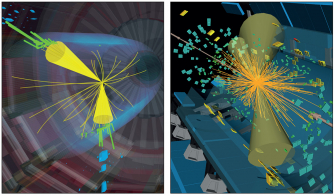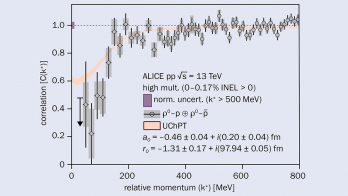A report from the CMS experiment.

Understanding hadronic final states is key to a successful physics programme at the LHC. The quarks and gluons flying out from proton–proton collisions instantly hadronise into sprays of particles called jets. Each jet has a unique composition that makes their flavour identification and energy calibration challenging. While the performance of jet-classification schemes has been increased by the fast-paced evolution of machine-learning algorithms, another, more subtle, revolution is ongoing in terms of precision jet-energy corrections.
CMS physicists have taken advantage of the data collected during LHC Run 2 to observe jets in many different final states and systematically understand their differences in detail. The main differences originate from the varying fractions of gluons making up the jets and the different amounts of final-state radiation (FSR) in the events, causing an imbalance between the leading jet and its companions. The gluon uncertainty was constrained by splitting the Z+jet sample by flavour, using a combination of quark–gluon likelihood and b/c-quark tagging, while FSR was constrained by combining the missing-ET projection fraction (MPF) and direct balance (DB) methods. The MPF and DB methods have been well established at the LHC since Run 1: while in the DB method the jet response is evaluated by comparing the reconstructed jet momentum directly to the momentum of the reference object, the MPF method considers the response of the whole hadronic activity in the event, recoiling versus the reference object. Figure 1 shows the agreement achieved with the Run 2 data after carefully accounting for these biases for samples with different jet-flavour compositions.
Precise jet-energy corrections are critical for some of the recent high-profile measurements by CMS, such as an intriguing double dijet excess at high mass, a recent exceptionally accurate top-quark mass measurement, and the most precise extraction of the strong coupling constant at hadron colliders using inclusive jets.
The expected increase of pileup in Run 3 and at the High-Luminosity LHC will pose additional challenges in the derivation of precise jet-energy corrections, but CMS physicists are well prepared: CMS will adopt the next-generation particle-flow algorithm (PUPPI, for PileUp Per Particle Id) as the default reconstruction algorithm to tackle pileup effects within jets at the single-particle level.
Jets can be used to address some of the most intriguing puzzles of the Standard Model (SM), in particular: is the SM vacuum metastable, or do some new particles and fields stabilise it? The top-quark mass and strong-coupling-constant measurements address the former question via their interplay with the Higgs-boson mass, while dijet-resonance searches tackle the latter.
Underlying these studies are the jet-energy corrections and the awareness that each jet flavour is unique.
Further reading
CMS Collab. 2021 CERN-CMS-DP-2021-033.
CMS Collab. 2021 CERN-CMS-DP-2021-001.
CMS Collab. 2022 CMS-PAS-TOP-20-008.








